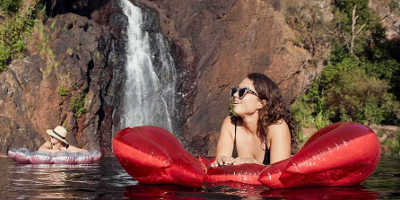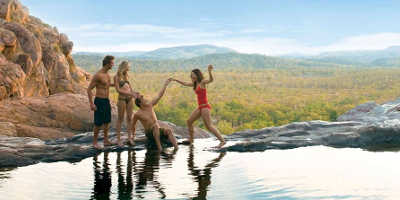
Visit the Ubirr Rock Gallery
Written by: Cameron Ward
Published: 11/08/2019
Reading time: 3 mins
Don’t miss one of Kakadu’s most famous rock art galleries, the Ubirr Rock Art Gallery.
Kakadu National Park is alive with cultural significance and Indigenous history. Ubirr is one of the most famous, and popular, sites showcasing Aboriginal history. This impressive rock formation is home to an extensive collection of rock art.
Following a 1km circular walking track, you’ll visit the gallery sites. Here you can see centuries-old rock-art paintings in a variety of art styles. You’ll also get to see how many of the newer paintings have been superimposed over older ones.
The art
The paintings at Ubirr tell the stories of local law and behaviours. There are information boards at the Mabuyu, Namarrgarn Sisters and Rainbow Serpent paintings. They provide information on the paintings meaning and stories. Locals believe that Garranga’rreli, the Rainbow Serpent, travelled through Ubirr in her human form. While there she painted an image of herself on the rock to remind people of her presence in the area.
The Main Gallery features mainly x-ray style paintings. They depict the abundance of food available around Ubirr. Many of the species are still in the area, over 1500 years after the paintings creation. You can see paintings of fish, mussels, goanna, and echidna amongst others.
Additionally, the Main Gallery holds early contact art. This art depicts the first contact Aboriginal people had with invading Europeans. There is a particularly famous painting of a ‘white fella’. He is in boots and has his hands in his trouser pockets, likely painted in the 1880’s.
Close to the main gallery is a painting of a thylacine. It is estimated the animal went extinct on the Australian mainland more than 2000 years ago.
Leaving the main track, make the 500m journey up to the Ubirr lookout. Along the way, you will find the Namarrgarn Sisters and the Crosshatching gallery. Here you will see different styles of painting.
Protecting the art
Conserving the art at Ubirr is incredibly important to the local Aboriginal people. Additionally, it is an important scientific record of human occupation of Kakadu. There are many natural causes for erosion of rock art and aids are used to help prevent damage.
Handrails and boardwalks prevent people and animals from rubbing against the rocks. Additionally, they prevent dust kicked up by visitors and covering the work.
Rangers have also added silicone drips around the edges of many paintings. This prevents water flowing down the rock from running over the painting. It also reduces mould growing over the paintings.
Today, the art at Ubirr is protected by neighbouring clans, the Bunitj, Manilagarr, and Mandjurlgunj people. They ensure the art and its stories are protected. These processes will help protect the art for future generations.
The Ubirr Rock Art Gallery is a stunning example of human occupation in Kakadu National park. It is easily accessible by road in the wet and dry season. Leave yourself at least an hour and a half to fully enjoy the art circuit walk and nearby Ubirr lookout. These incredible works of art will enhance every Kakadu National Park trip.
Related article: Exploring Aboriginal Rock Art at Kakadu









